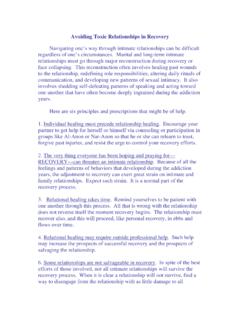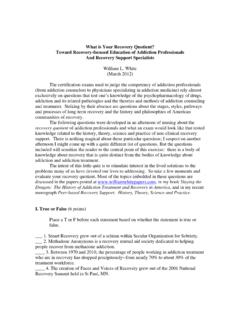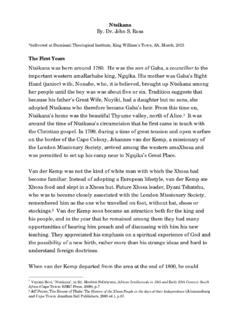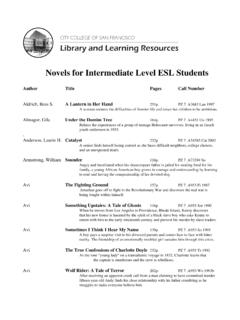Transcription of From Private Grief to Public Advocacy: An Interview …
1 1 White, W. (2013). From Private Grief to Public advocacy: An Interview with Jim Contopulos. Posted at From Private Grief to Public Advocacy: An Interview with Jim Contopulos William L. White Introduction There are few experiences more devastating and isolating than losing a son or a daughter or brother or sister in an addiction-related death. For decades, the pain of these family members has been experienced in silence with only occasional breakthroughs in Public consciousness of their existence ( the late Senator George McGovern s publication of Terry: My Daughter s Life and Death Struggle with Alcoholism.) One of the things the new recovery advocacy movement in the United States has attempted to do is to mobilize these family members for mutual support and Public advocacy.
2 In June of 2013, I had the opportunity to Interview Jim Contopulos, one such family advocate about his loss and a film he has created to help change how this country views and responds to its addicted citizens. Please join us in this deeply moving discussion. Bill White: Jim, first, thank you for agreeing to share your experiences in this Interview . Could you begin by sharing the story behind the film, Beautiful Boy .. More Than An Addict? Jim Contopulos: Absolutely, and thank you. The film is about my son Nick, who died on May 29th, 2010, at the age of 26. In the film, I take you on a walk as I look back and lament the loss of our beautiful boy. Nick began experimenting with drugs somewhere around the age of 13. Like so many, he started with alcohol and then on to marijuana. Soon, Nick became enamored with drugs and their affect on him. He once told me that he loved being high and wanted to try every drug that was out there.
3 While I appreciated his honesty, I knew that the drugs available to him such as methamphetamines and heroin were extremely potent and readily available. I was terrified and had absolutely no idea what to do or where to turn for help. Looking back now, we estimate that Nick was in over 20 residential treatment programs and was admitted to our County s emergency mental health facility over 70 times. He had become addicted to drugs as well as someone who carried a mental health disorder of bi-polar with extreme anxiety. We call that a dual diagnosis or someone with a co-occurring disorder and we would soon find out that navigating our society s haphazard, fragmented system of care , left Nick and those of us who loved Nick, despairing and without hope. But Nick was more than an addict. He was my son and my beautiful boy. He was extremely bright and quick witted, with a love of friends, family and animals.
4 The late Irish poet, John O Donohue once said All of us, even our ill, are much greater than our biographies . And so it was with Nick and with the many other Nicks who crowd our shadows. The title for the film came, in part, from David Sheff s remarkable book, Beautiful Boy which was his own desperate journey from following his son into the world of addiction and mental illness. Nick had read both 2 this book and the one by David Sheff s son, and mentioned to me many times Dad, you know, you and I could have written these books. How true that became. Finding long term, affordable, quality, multi-dimensional, recovery and care grounded in evidenced based, best practices left Nick and those of us who loved him, with, in the words of Father Greg Boyle, a fatal absence of hope . So many times, we witnessed Nick s courageous and honorable work of recovery only to relapse and experience the tears of self loathing.
5 For 13 years Nick experienced this as well as the stigmatization, loneliness and misunderstanding of his disease. Towards the end, Nick would say to me, Dad, I don t use heroin anymore to get high; I just use heroin to feel normal . And my heart would break. At the beginning, in a desire to feel at peace in his own head and skin, Nick chose to use drugs. What he didn t know, nor did any of us, is that he opened a door he alone, could not close, no matter how hard he and we tried. While he made the choice to use drugs at the beginning, he never chose to become addicted. No one does. Bill White: I m assuming from what you said, Jim, that Nick experienced a variety of treatments over those years and exposure to various support groups. Is that correct? Jim Contopulos: Yes. At the age of 15 we placed Nick in his first of many, long term residential treatment centers.
6 This was the beginning of many years of cycling in and out of residential treatment centers throughout the country. In the beginning, we felt, perhaps, that we could buy recovery. We were desperate to save his life and have our son return to us. Like many desperate and well meaning loved ones, we fell prey to what I call the 30/60/90 day false promises. It took us and Nick, many years and many efforts to realize that recovery can not be purchased. Many times, we witnessed Nick s hard work of recovery and recovery s reward of self respect, only to experience the devastation of this relentless, chronic, terminal disease. Once we realized that recovery could not be purchased we continued to support Nick in his own efforts to find recovery at the many free recovery locations such as Salvation Army. In nearly all these recovery locations, the prevailing wisdom was that before the mental illness could be addressed, Nick had to be clean and sober for a significant period of time, which became increasingly difficult.
7 It is my understanding now that if one has a co-occurring disorder such as Nick s that the disorders need to be treated concurrently. That is a change that needs to continue. Without exception, Nick would begin the hard work of recovery without any help for his mental condition, and then relapse back to drugs and be kicked out to the street. I now know of facilities that we are beginning to see relapse as a symptom of the disease and are beginning to respond to relapse differently. I only wish that had occurred for Nick. In the end, the only place where Nick truly found relief from his mental state was with heroin, which, in time, became his own ball and chain . Bill White: Do you have a sense that addiction treatment helped but at the same time also failed Nick and your family? 3 Jim Contopulos: Absolutely. Because we loved him so much, and felt extremely desperate and hopeless for him and with him, we fell prey to our current system of care.
8 I do believe there was help for Nick to begin recovery, but what lacking were quality help, support and structure to sustain his recovery. Nick participated in several short term cognitive behavioral therapy recovery programs, but was unable to sustain the recovery due to either the cost or the availability of the residential bed . Eventually, both our resources for Nick and the Public resources were drained, as he would wait weeks for any available bed. The irony of all of this, is that Nick was incarcerated a total of approximately 3 years between prison and jail. If only a small portion of the amount spent on incarcerating Nick, would have been spent on long term recovery, everyone, the taxpayer and Nick, would have been much better served. However, there was no long term culture of recovery that was available to Nick that would address both disorders.
9 Despite this, Nick would begin the hard work of recovery again and again, and would sustain recovery for weeks or months and would love it. He loved recovery, being in recovery meetings and its reward of self-respect. I know how odd that may sound since Nick died as a result of a relapse and a failed effort to detox himself. But it is true. What he and we came to realize and respect was the power of this disease to destroy both his life and those of us who loved him. In recovery, they call this illness a cunning, powerful, and baffling disease and both we and Nick experienced this reality many times. Bill White: With your references to Nick s heroin addiction, some of our readers will wonder f Nick had access to the major medications used to treat heroin addiction; methadone, buprenorphrine, or naltrexone. Jim Contopulos: Yes he did. Like many addicts, Nick cycled in and out of the criminal justice system.
10 Because he, himself, had no resources, he asked for my help in paying for daily Methadone treatments so he wouldn t relapse and be placed back into prison. With conditions, we did this for him at a cost of $280 per month. During this time, Nick continued with his 12-step meetings and to live in a sober environment. In time, he was released from parole and felt extremely proud of this accomplishment. Regretfully, rather than stay on Methadone and with the conditions we established, Nick chose to detox himself from Methadone. The State of California allows a Methadone facility to detox a client, regardless of the current dosage of Methadone, in as little as 15 days. Witnessing Nick s detox from Methadone was horrific. I can t help but think that we wouldn t allow this type of inhumane treatment for an animal, much less somebody as vulnerable as Nick. Some time after the work with Methadone, Nick went under the care of a doctor who subscribed Suboxone (buprenorphrine) for his opiate addiction and Xanax for his anxiety.















